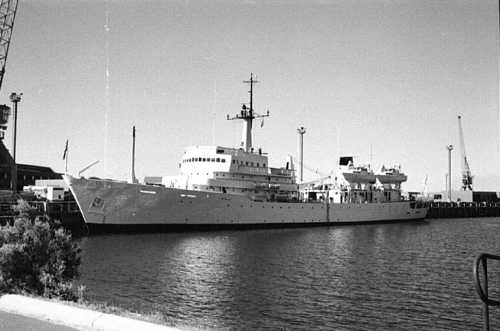- Author
- Doyle, J.J., A.M, Captain, RAN (Rtd)
- Subjects
- Biographies and personal histories, History - pre-Federation
- Tags
-
- RAN Ships
- HMAS Moresby I
- Publication
- September 2006 edition of the Naval Historical Review (all rights reserved)
HMAS Moresby was named for Admiral John Moresby, RN. It was the third ship to carry that name; the first, HMS Moresby, a World War I destroyer, had the distinction of being the only Royal Navy ship named after a living officer. The subsequent Moresbys were survey ships of the Royal Australian Navy.

(Photo: Graeme Andrews)
During a Moresby Reunion in November 2005, the Administrator of Norfolk Island suggested that a Moresby was involved with the Third Settlement of Norfolk Island. However, there is some doubt that an officer called Moresby was directly associated with Norfolk Island. In fact it was a Captain H.M. Denham, RN, in HMS Herald, who was the Royal Navy Surveyor who oversaw the establishment of the Pitcairn Islanders on Norfolk Island. Whether a Moresby was with him is unclear at this remove.
However, subsequent investigations have uncovered some interesting connections with the island, and interconnections between the Fremantle, Moresby and King families.
Fairfax Moresby
The first tenuous contact between Norfolk Island and the name Moresby goes back to Fairfax Moresby, John Moresby’s father.
Fairfax Moresby made a name for himself in the closing stages of the Napoleonic War when he was in command of the brig HMS Wizard in the Mediterranean. In just one year in that ship, he captured two French privateers and sixty merchant ships. In addition to the hundred guinea sword awarded to him, he would have become very wealthy with prize money, the reason his crew would have been very sorry to see him leave the ship. In their farewell letter to him, the ship’s company speak of him as ‘so valuable a Captain’. At this time, his Senior Officer was Rear Admiral Fremantle.
Later, in 1819, Captain Fairfax Moresby, now in command of the 26-gun frigate HMS Menai, was seaguard off St. Helena, where Napoleon was being held. Moresby then became the Senior Naval Officer at Port Louis, Mauritius. He oversaw the establishment of 2000 British colonists in Port Elizabeth in the Cape Colony, and began enforcing Wilberforce’s Anti-Slavery Act on the East Coast of Africa.
Norfolk Island’s most illustrious son, Phillip Parker King, born in Government House on Norfolk Island on 13 December 1791, was at this time surveying the north west coast of Australia in HMS Bathurst. King had to take Bathurst to Mauritius for repairs. Fairfax Moresby proved to be most generous with personnel and materiel and provided great sustenance to Bathurst during September 1821. To record his appreciation, King named a number of geographic features in the Geraldton area of Western Australia with reference to Moresby (Moresby Flat Topped Range, Wizard Peak, etc.). It is interesting to note that Fairfax Moresby was only five years older than King.
After his promotion to Rear Admiral, Fairfax Moresby was nominated in 1849 as Commander in Chief of the Pacific Station, with his flagship, the 50-gun frigate HMS Portland.
Moresby personally visited Pitcairn Island on two occasions. He was impressed with George Nobbs whom he met on the island. Nobbs, born in 1799, had been a Midshipman and Lieutenant in the Royal Navy and had had an exciting career in Chile and Peru under the famous swashbuckling Lord Cochrane. Nobbs moved to Pitcairn in 1828. Before John Adams, the last surviving Bounty mutineer, died in 1829, Adams had bequeathed his place of authority to Nobbs. It was the earnest desire of the Pitcairn Islanders that Nobbs should be ordained into the church. It thus fell upon Fairfax Moresby to pay personally for Nobbs’ passage to England and return. Nobbs was subsequently ordained by the Archbishop of Canterbury. He was also received by Queen Victoria. Moresby was to become Admiral of the Fleet Sir Fairfax Moresby, GCB, KMT, DCL. He died in 1877.
Henry Mangles Denham
After a survey of Patagonian waters, Phillip Parker King returned to Australia and in due course was promoted Rear Admiral of the Blue.
Denham supervised the establishment of the Third Settlement on Norfolk Island between the initial landing on 8 June 1856 until Herald’s departure on 26 June. Apparently the Islanders were expecting Fremantle in HMS Juno, with whom they had previously established some rapport when that ship had called at Pitcairn in 1855. Juno subsequently arrived on 22 June. As senior ship, responsibility for the operation was transferred to her. It was during this period that Denham completed his survey, from which Chart BA 1110, ‘Norfolk and Philip (sic) Islands’ was published on 4 April 1856, and which was subsequently re-published as a Modified Australian Reproduction. Denham’s chart was in use for 140 years.




